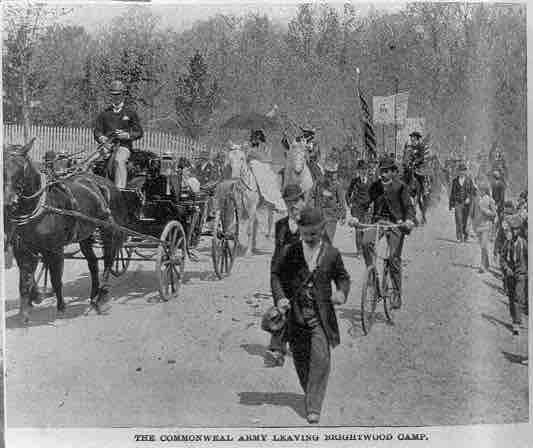Coxey's Army was a protest march by unemployed workers from the United States, led by Ohio businessman Jacob Coxey. The workers marched on Washington, D.C., in 1894, the second year of a four-year economic depression that was the worst in U.S. history up to that time. Officially named the "Army of the Commonweal in Christ," the march's nickname, "Coxey's Army," came from its leader and was more enduring. It was the first significant popular protest march on Washington, and the expression, "Enough food to feed Coxey's Army" originates from this march.
The purpose of the march was to protest the unemployment caused by the Panic of 1893 and to lobby for the government to create jobs that would involve building roads and other public works improvements. The protesters also demanded that workers be paid in paper currency, which would expand the currency in circulation, consistent with populist ideology. The march originated with 100 men in Massillon, Ohio, on March 25, 1894. It passed through Pittsburgh, Becks Run, and Homestead, Pennsylvania, in April.
The march's western section received the nickname "Kelly's Army," after California leader "General" Charles T. Kelly. Although larger at its outset, Kelly's Army lost members on its long journey; few made it past the Ohio River. Various groups from around the country gathered to join the march, and its number had grown to 500 with more on the way from further west when it reached Washington on April 30, 1894. The 260-acre Shreve farm site at current day Colmar Manor, Maryland, was used by the 6,000 jobless men as a camp site. Coxey and other leaders of the movement were arrested the next day for walking on the grass of the U.S. Capitol. Interest in the march and protest rapidly dwindled.
Some of the most militant Coxeyites were those who formed their own "armies" in Pacific Northwest centers such as Butte, Tacoma, Spokane, and Portland. Many of these protesters were unemployed railroad workers who blamed their plight on railroad companies, President Cleveland's monetary policies, and excessive freight rates. The climax of this movement was perhaps on April 21, 1894, when William Hogan and approximately 500 followers commandeered a Northern Pacific Railway train for their trek to Washington, D.C. They enjoyed support along the way, which enabled them to fight off the federal marshals attempting to stop them. Federal troops finally apprehended the Hoganites near Forsyth, Montana. While the protesters never made it to the capital, the military intervention they provoked proved to be a rehearsal for the federal force that broke the Pullman Strike later that year.

Coxey's Army
Coxey's Army marchers leaving their camp.